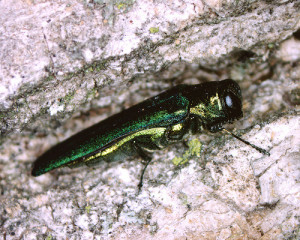By Art Lander Jr.
Frankfort, KY. – A 1/2-inch long dark metallic green beetle is responsible for the loss of tens of thousands of ash trees across northern and central Kentucky.
The emerald ash borer, Agrilus planipennis, a native to Asia, was first documented in the state in 2009.
“The emerald ash borer has now spread to 21 Kentucky counties at a minimum,” said Jody Thompson, an environmental scientist with the Kentucky Division of Forestry. “From three years of trap data, University of Kentucky researchers found that one of the largest (infestations) and potentially oldest is in the northern Franklin and Shelby County area.”

Adult beetles emerge in late spring from May to early June and feed on ash leaves. After mating occurs, females lay 60 to 90 eggs on a nearby ash tree.
It’s the larvae, the immature stage of the beetle, causing the damage from feeding on the inner bark (phloem) and disrupting the tree’s ability to transport sugars and other nutrients.
“If enough of the flow is cut, the tree will stress and eventually die,” said Thompson.
The most reliable signs of this beetle are the D-shaped holes in the bark from which adults emerge. Another sign is finding an adult beetle. Infested trees often exhibit a discoloration of the bark as woodpeckers try to get at the larvae. Branches in the tree’s canopy die and sometimes suckers grow from the tree’s trunk.
Typically, it takes about two years for a mature ash tree to succumb to the emerald ash borer. Ash trees in cities and suburbs are just as vulnerable as those in rural woodlands.
Ben Robinson, small game biologist for the Kentucky Department of Fish and Wildlife Resources, said it would be a big loss to wildlife if Kentucky’s ash trees disappeared.
“Ash trees are valuable as a seed source,” he said, “for songbirds, bobwhite quail, wild turkeys and even wood ducks in bottomland hardwood forests.”
The exotic, invasive beetle probably arrived in North America in wood shipping crates carried by cargo ships. The Emerald ash borer was discovered in North America in 2002. By 2012, the beetle had spread to at least 17 U.S. states.
In years to come, Kentuckians could be looking at a landscape with few, if any, ash trees. “Ash trees sucker and grow well from seed, so there’s likely to be a small lingering population,” Thompson said.
All species of ash trees native to Kentucky, including the white ash, green ash and blue ash, are susceptible to the emerald ash borer. The blue ash, an heirloom of Kentucky’s pre-history, still survives in remnant savannas of the Inner Bluegrass Region.
“Fayette County has been chemically treating some of their large blue ash trees,” said Thompson. “To be effective, chemical treatment has to be continuous.”
Ash wood has a high strength-to-weight ratio and low shrinkage when dried. It is a valuable wood with many commercial uses for everything from flooring and electric guitar bodies, to tool handles and baseball bats.
For the most up-to-date information on the emerald ash borer in Kentucky visit: http://pest.ca.uky.edu/EXT/EAB/welcome.html.
Art Lander Jr. has been writing about the outdoors since the 1970s. He is a staff writer for Kentucky Afield Magazine.
Media Contact: Lee McClellan 1-800-858-1549, ext. 4443


Be the first to comment